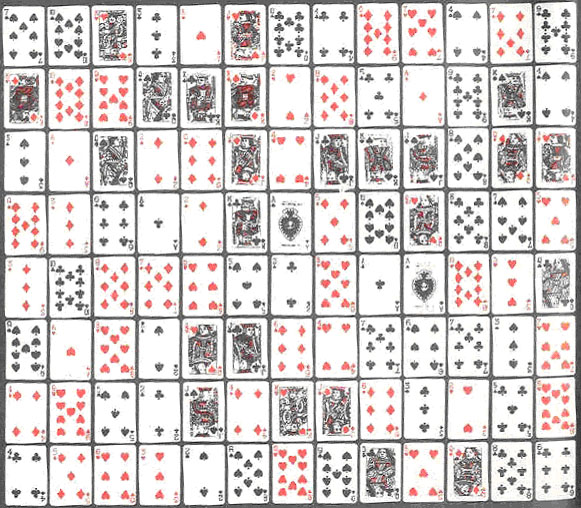PAGANINI
DOUBLE-PACK
Paganini is a double-pack patience game, similar in principle to but more interesting than, the single-pack game known as Spades. It was composed by Mr Charles Jewell.
The entire pack is dealt face upwards on the table in eight rows of 13 cards each, as shown in the illustration overleaf.
The entire pack is dealt face upwards on the table in the eight rows of 13 cards each, as shown in the illustration overleaf.
The object of the game is to arrange the cards so that each row consists of one suit beginning with an Ace (on the left) and ending with a King (on the right). No row is singled out for any particular suit; the player makes his own decision but, having made it, must not alter it.

Play begins by moving one of the Aces to the extreme left of a row. It will be appreciated, therefore, that as the poker game proceeds the whole of the layout is moved one space to the left so to speak. When a card is moved it leaves a space in the layout which is filled with the next higher card of the same suit as the card on the left of the space.
Filling a space leaves another space in the layout. In turn this is filled in the same way, and so on, until a run is brought to an end by removing a card from the right-hand side of a king, because no card is available to be played to the space on the right of a King.
The game calls for a show of skill. To begin, a player has to decide which of the eight Aces he will move first and to the extreme left of which of the eight rows he will move it to. Then, whenever a card is moved in the layout, there is, at all events early in the play, a choice of two cards to fill the available space.
It will be seen, therefore, that when all eight Aces have been moved to the extreme left of the layout, each move will offer the choice of filling one of eight spaces with either of two cards.
The layout in the illustration is not as difficult as it may appear. Indeed, with a little care the online poker game should be won.
After a general survey of the possibilities in the game, the ♥ A in the bottom row should be moved to the extreme left of the row; the ♥ Q in the fifth row is moved to the space left vacant by the ♥ A; and the ♣ 9 in the bottom row is moved into the space left vacant by the ♥ Q.
The space left vacant by the ♣ 9 may be filled either with the ♥ 2 in the second row or the one in the seventh row.
Consideration shows that it should be filled with the one in the second row, because the ♣ 6 in the top row can be moved into the vacant space, the ♣ A in the fifth row can be moved to the extreme left of the top row, the ♣ 6 in the top row can be moved to the space in the second row left vacant by the ♥ 2, and either the ♣ 2 in the second row or that in the fourth row can be moved into the space (alongside the ♣ A) left vacant by the ♣ 6. And so on.
